| Pages:
1
2
3
4 |
Trifluoroacetic
Hazard to Others
  
Posts: 128
Registered: 6-8-2008
Member Is Offline
Mood: No Mood
|
|
Thanks for sharing I will try this.
Quote: Originally posted by #maverick#  | saw this on ozone's site seemed interesting might give it a try
Dicopper (II) Acetyloxybenzoate synthesis
16, 300mg Aspirin tablets are crushed.
The resultant powder is dissolved in 100ml of a 1M Potassium Carbonate solution to dissolve the Acetylsalicylic Acid.
The insoluble binders are then removed via vacuum filtration.
The remaining solution is then acidified to pH1 with 10% Hydrochloric Acid to precipitate out the Acetylsalicylic Acid from solution.
This foamy solution is then vacuum filtered and washed with more dilute Hydrochloric Acid to obtain a more pure product.
This is then re-dissolved in the minimum amount possible of Potassium Carbonate solution, just so much that there are no unreacted reactants.
This solution is then combined with a previously prepared 0.01M solution of Copper Sulphate with stirring.
Bright blue crystals of Dicopper (II) Acetyloxybenzoate precipitate immediately.
These crystals are vacuum filtered. This is an extremely slow process. |
|
|
|
The WiZard is In
International Hazard
    
Posts: 1617
Registered: 3-4-2010
Member Is Offline
Mood: No Mood
|
|
Ma Nature makes some nice copper compounds....
Dioptase tops my list.
http://en.wikipedia.org/wiki/Dioptase
Chrysocolla
http://en.wikipedia.org/wiki/Chrysocolla
Bornite
http://en.wikipedia.org/wiki/Bornite
Come upon my mind. Granted Ma has time on her side...
just set up an endowment to fund you experiments over
several thousands of generations.
Assuring that you were continual cloned would be a help.
----
Branch out to beryllium?!
Chapter 10. Artificial and Synthetic Beryls
John Sinkankas
Emerald and Other Beryls
Clinton Book Company 1981
djh
----
Extracted from :—
Harvey Mansfield
Sociology and Other 'Meathead' Majors
Archie Bunker was right to be skeptical of his son-in-law's opinions
Wall Street Journal 21V11
Science has knowledge of fact, and this makes it rigorous and
hard. The humanities have their facts bent or biased by values,
and this makes them lax and soft. This fact—or is it a value?—
gives confidence and reputation to scientists within the university.
Everyone respects them, and though science is modest because
there is always more to learn, scientists sometimes strut and often
make claims for extra resources. Some of the rest of us glumly
concede their superiority and try to sell our dubious wares in the
street, like gypsies. We are the humanists.
Others try to imitate the sciences and call themselves "social
scientists." The best imitators of scientists are the economists.
Among social scientists they rank highest in rigor, which means in
mathematics. They also rank highest in boastful pretension, and
you can lose more money listening to them than by trying to read
books in sociology. Just as Gender Studies taints the whole
university with its sexless fantasies, so economists infect their
neighbors with the imitation science they peddle. (Game theorists,
I'm talking about you.)
It's no wonder, then, that students make poor choices, avoiding
difficult courses, stumbling into easy ones, embracing counterfeit
majors. One might hope that with common sense they could learn
from experience, but according to the fact-value distinction,
experience cannot be shown to give one better judgment. There is
no "better" judgment. That's what colleges teach their students
these days.
Mr. Mansfield, a professor of government at Harvard, is also a
senior fellow of Stanford's Hoover Institution.
|
|
|
The WiZard is In
International Hazard
    
Posts: 1617
Registered: 3-4-2010
Member Is Offline
Mood: No Mood
|
|
There dobe no doubt a SL of these in Mellors 16 volume (plus sps.)
opus, this ones name attracted my attention.
Copper nickelous dihydropentasulphate
A. Étard* obtained rose-coloured crystals of ... 2(CuSO4)-(NiSO4)-
H2SO4, by heating in a sealed tube at 200o, a soln. of the mixed
salts in the smallest possible proportion of water, and a large
excess of conc. sulpuric acid.
*Compt. Rend.,87. 602, 1878?
|
|
|
The WiZard is In
International Hazard
    
Posts: 1617
Registered: 3-4-2010
Member Is Offline
Mood: No Mood
|
|
There dobe no doubt a SL of these in Mellors 16 volume (plus sps.)
opus, this ones name attracted my attention.
Copper nickelous dihydropentasulphate
A. Étard* obtained rose-coloured crystals of ... 2(CuSO4)-(NiSO4)-
H2SO4, by heating in a sealed tube at 200o, a soln. of the mixed
salts in the smallest possible proportion of water, and a large
excess of conc. sulpuric acid.
*Compt. Rend.,87. 602, 1878?
|
|
|
MrHomeScientist
International Hazard
    
Posts: 1806
Registered: 24-10-2010
Location: Flerovium
Member Is Offline
Mood: No Mood
|
|
Quote: Originally posted by Trifluoroacetic  | | I have also made CuCl2, CuCl, CuI, CuBr2, copper carbonate, hydroxide, and the oxide, I'm thinking about trying to make the trifluoroacetate salt
also. |
When you made the hydroxide, did you successfully get a nice dry sample? I've had a lot of trouble drying Cu(OH)2 without it decomposing into CuO or
reacting with CO2 to make the carbonate. I start with a nice light blue voluminous, goopy precipitate but after washing and air drying it inevitably
turns black or dark green. I've heard that cooling helps, and perhaps a dessicator bag is the way to go.
More related to your question, have you seen this compound from woelen's site? It's a really beautiful purple color and something I want to try
myself, once I find some Na-DCCA.
http://woelen.homescience.net/science/chem/exps/raw_material...
|
|
|
The WiZard is In
International Hazard
    
Posts: 1617
Registered: 3-4-2010
Member Is Offline
Mood: No Mood
|
|
Quote: Originally posted by MrHomeScientist  |
When you made the hydroxide, did you successfully get a nice dry sample? I've had a lot of trouble drying Cu(OH)2 without it decomposing into CuO or
reacting with CO2 to make the carbonate. I start with a nice light blue voluminous, goopy precipitate but after washing and air drying it inevitably
turns black or dark green. I've heard that cooling helps, and perhaps a dessicator bag is the way to go. |
It do claimed you get copper hydroxide by reacting copper sulphate
with strong ammonia water. Don't know 'bout drying it though.
Another book sez. Copper(II) hydroxide is precipated by
treating a soluble copper(II) salt such as CuCl2 or CuSO4
with caustic soda or caustic potash.
Walks out to the living room and removes volume II or Brauer's
Handbook of Preparative Inorganic Chemistry from one of the three
bookcases Yup - complete details for copper(II) hydroxide on
pages 1013-14. Followed by Potassium cuprate(II) - a steel-blue to
deep blue crystalline powder.
I don't lend books and am not in the mood to scan this so....
you are going too have too go to the forums library and DL a
free copy.
Brauer should keep you busy to Christmas. Oh and while
you are doing the copper sulphate - ammonia water - sodium
hydroxide thing... you can make rayon.
http://tinyurl.com/3crfovu among a zillion other URL's.
djh
----
Wlat Street Journal
10 iv 2001
RINGSIDE LABOR: The bell hasn't rung on a
boxing union, supporters say.
The New York City-based Fighter's Institute
for Survival and Training, or Fist,
helps boxers with a life outside the ring.
But the group, founded by boxer Gerry
Cooney, also hopes someday to become
a union for boxers. Goals could include
minimum standards, as with actors, says
Joe Sano, Fist's president and an
official at an Office and Professional
Employees Internationals Union local. "The
whole idea is to crawl, walk, run," Mr.
Sano says.
That pace sounds familiar to Paul Johnson,
a Minneapolis ex-boxer. He has tried
to get the Boxers' Organizing committee
off the ground for about 12 years, but
plans to unveil the group before a televised
title fight never seem to come
together. Still, he believes a union is imminent.
"We've got the rocket ship on the pad,
we're pumping liquid nitrogen, and we're
going to blast off," he says.
[I hope they are not planning on a long trip! /djh/]
|
|
|
The WiZard is In
International Hazard
    
Posts: 1617
Registered: 3-4-2010
Member Is Offline
Mood: No Mood
|
|
Quote: Originally posted by The WiZard is In  |
Perhaps the simplest to make and best saturated blue copper
chemical is "tetraamminecopper sulphate". Just add ammonia
water to copper sulphate. However, I have never tried to dry it.
Something in the back of my mind says - add a little alcohol.
I don't have time to try it now.
|
Found it - alcohol and all — it dobe in Brauer's Handbook of Preparative
Inorganic Chemistry, volume II page 1021.
You can DL a copy from the forums library among other sites.
djh
----
Dewey, Cheatham, and Screw
Investment Mavens
43 Park Row
New York, N.Y. 00001
CONFIDENTIAL PRIVATE OFFERING MEMORANDUM
Dear Client;
I have been looking around for a really good sound business deal that will not only be a
good investment but will also give some tax benefits. As you can imagine, there are few
opportunities around that give real profit potential and also may be classified as conser-
vative, sound investments.
Fortunately, I have found a real "sleeper" I though I would mention to you because
(although conservative) it looks like it will make a lot of money with very little invested
cash.
A friend of mine is opening a large cat ranch near Karmasillo, Mexico. It is our purpose
to start small; just one million cats. Cat skins can be sold for about 20 cents for the white
ones and up to 40 cents for the black. Each cat averages about 12 kittens a year; this will
give up about 12 million cat skins the first year, at an average of around 32 cents, making
our revenue about $3 million a year. This averages $10,000 a day excluding Sundays and
holidays.
A good Mexican cat person can skin about 50 cats a day. He or she gets $3.15 a day. It
will only take 663 people to operate the ranch, so the net profit will be more than $8200
per day.
The cats will be feed exclusively on rats. We will start a rat ranch adjacent to our cat
farm. Here is where the first year tax break really comes in. Because we will be utilizing
the rats to feed the cats, we can claim the expense of the entire first batch of rats
purchased during 1985. Rats multiply about times faster then cats do. If we start with a
million rats at a nickel each, we will have four rats per cat per day and a whopping
$50,000 1987 tax deduction.
Now here's the real innovation. The rats will be fed on the carcasses of the cats we skin.
This will give each rat one quarter of a cat. You can see by this that the business is a
clean, self-supporting operation: automatic throughout. The cats will eat the rats, the rats
will eat the cats, and we will get the skins and the tax benefits. Incidentally, the ecologists
think it's great.
Eventually, we hope to cross the cats with snakes. Snakes skin themselves twice a year.
This will save the labour costs of skinning and will also give us the yield of two skins for
one cat.
Let me know as soon as possible if you are interested. Naturally, we want to keep this
deal limited to the fewest investors possible.
[Edited on 1-6-2011 by The WiZard is In]
|
|
|
Arthur Dent
National Hazard
   
Posts: 553
Registered: 22-10-2010
Member Is Offline
Mood: entropic
|
|
Copper Phosphate?
An odd thing happened recently, I was trying to prepare a little bit of copper phosphate with a little ball of clean telephone wire (pure copper) and
an aqueous solution of pure phosphoric acid (5%).
After pickling for a while in a jar, my resuls were somewhat surprzing. I obtained a perfectly clear, sky blue solution. Isn't copper phosphate
supposed to be insoluble? Or is the remaining phosphoric acid keeping the phospate dissolved?
I was thinking I would have obtained at least a bit of a precipitate, but the stuff is perfectly dissolved, with not a trace of anything at the
bottom...
The phosphoric acid MSDS says it is pure, and the telephone wire I have has been used often to succesfully synthetize the sulphate, the chloride and
the basic carbonate...
Robert
--- Art is making something out of nothing and selling it. - Frank Zappa ---
|
|
|
Mr. Wizard
International Hazard
    
Posts: 1042
Registered: 30-3-2003
Member Is Offline
Mood: No Mood
|
|
What happens if you neutralize the remaining acid with a little sodium bicarbonate? Later today, I'll try a little Phosphoric Acid on the Copper
Phosphate I made and see if it dissolves in the acid. The only Phosphoric Acid I have is a concrete etching product that contains other ingredients.
|
|
|
#maverick#
Hazard to Others
  
Posts: 209
Registered: 7-4-2011
Member Is Offline
Mood: hybridised
|
|
An easier way to prepare copper phosphate is by reacting soln of cuso4 with a soln of Na3PO4 which can be bought at home depot
|
|
|
Mr. Wizard
International Hazard
    
Posts: 1042
Registered: 30-3-2003
Member Is Offline
Mood: No Mood
|
|
@ Arthur Dent, I tried a little Concrete etchant which contains Phosphoric Acid on both Copper powder and my Copper Phosphate. The results surprised
me. The Copper powder ( from an old CuSO4 + Vitamin C experiment), did produce a pale blue solution, but didn't react much with the Copper powder
after heating with a candle for a few minutes. The Copper Phosphate however did dissolve much more than I thought it would. With warming it did
produce a pale blue solution with a dilute Phosphoric Acid (Concrete Etch). It did not dissolve all the Copper Phosphate, however.
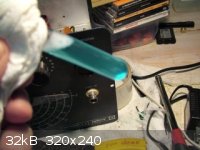
This shows the Copper Phosphate / Phosphoric Acid solution.
This may actually be useful, as my original use for the Copper Phosphate was to make artificial Turquoise by mixing with Aluminum Phosphate. Having
some of the Copper in solution may make the formation easier.
[Edited on 26-7-2011 by Mr. Wizard]
[Edited on 26-7-2011 by Mr. Wizard]
|
|
|
Mr. Wizard
International Hazard
    
Posts: 1042
Registered: 30-3-2003
Member Is Offline
Mood: No Mood
|
|
Due to my inexperience I can't seem to connect two photos to the post. Here is the powdered Copper with phosphoric Acid.
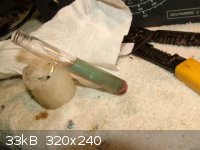
|
|
|
Arthur Dent
National Hazard
   
Posts: 553
Registered: 22-10-2010
Member Is Offline
Mood: entropic
|
|
@ Mr. Wizard: Thanks for confirming the solubility of Copper Phosphate in Phosphoric acid solution! So I guess that after a certain concentration, the
mixture of Copper Phosphate in Phosphoric acid stops reacting with the metallic Copper just short of starting to precipitate the Phosphate. That's why
my solution has been in a test tube for days and it's still clear and with not a trace of precipitate at the bottom, pretty much the same color as
your first pic.
As you suggested, i'll try to drop a little bit of Sodium Bicarbonate in a sample of the solution to see what happens, but won't this just precipitate
Copper basic Carbonate?
Robert
--- Art is making something out of nothing and selling it. - Frank Zappa ---
|
|
|
Mr. Wizard
International Hazard
    
Posts: 1042
Registered: 30-3-2003
Member Is Offline
Mood: No Mood
|
|
@ Arthur Dent, yes adding Sodium Bicarbonate would eventually produce a basic Copper Carbonate, but I speculate that would only happen after most of
the Phosphoric Acid had been converted to a Sodium Phosphate salt of some sort. While you added the Sodium Bicarbonate you could watch for fizzing
and release of CO2. I may go out to the shop later and neutralize the sample to see what happens.
Looking at a 72nd Edition CRC Handbook of Chemistry and Physics, it shows copper (II) orthophosphate Cu3(PO4)2.3H2O as being soluble in H3PO4, acids,
and NH4OH
The value for the Ksp= 1.39x10^-37 which makes it quite insoluble compared with many other 'insolubles'.
Edit to add that sodium bicarbonate did precipitate out what looked like the original copper phosphate . Since I didn't measure anything it's all
rather 'iffy'.
[Edited on 26-7-2011 by Mr. Wizard]
|
|
|
OctanitroC
Harmless

Posts: 21
Registered: 20-4-2012
Location: Near the nadir of a triangular state
Member Is Offline
Mood: Reduced
|
|
Has anyone managed to synthesize dry Copper (ii) Borate? I can only find spotty references about it on google. I've precipitated a slimy turquoise
precipitate from borax and CuSO4 solutions, however I didn't try to filter it. Maybe I'll try that again. I've also dissolved CuCO3 in citric acid
before to yield a sky blue solution, however the solution was too acid rich and excess citric acid goopified the solution when I tried to dry it. Has
anyone isolated either of those two compounds?
And then I discovered this charming young man had stolen my kidney!
|
|
|
EdMeese
Harmless

Posts: 16
Registered: 25-1-2013
Member Is Offline
Mood: No Mood
|
|
My favorite is copper(I) acetate, on the 'nothing worthwhile is easy' line of reasoning. I tried the InorgSyn sublimation procedure with some scrap
copper dust (not electrolytic powder as they say) and the yield was dismal, but I managed 15% after sublimation by reducing copper(ii) acetate in neat
acetic acid with the same scrap copper. It's a beautiful white going to properly clear when the crystals are large enough ... pics! I must take pics!
|
|
|
bbartlog
International Hazard
    
Posts: 1139
Registered: 27-8-2009
Location: Unmoored in time
Member Is Offline
Mood: No Mood
|
|
Copper borate
Successfully made some of what is probably copper borate.
Experimental
200mmol of copper sulfate pentahydrate (50g) were dissolved in 250g of warm water.
400mmol of boric acid (25g) were dissolved in 250g of hot (80-90C) water.
380mmol of sodium bicarbonate (32g) were dissolved in 300g of warm water.
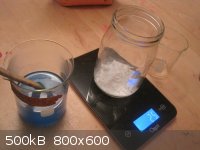
The first two solutions were combined by pouring the boric acid solution into the copper sulfate solution. No precipitate was seen even on close
examination. This is more or less in line with expectation - I wouldn't expect to be able to prepare sulfuric acid by precipitating copper borate from
a copper sulfate solution.
The solution was then transferred to a 1 liter mason jar, and gradually rendered more basic by piecemeal addition of the sodium bicarbonate solution,
with the expected foaming as the carbon dioxide was expelled from solution. Slightly less than the stoichiometric amount of sodium bicarbonate was
used so as to ensure that the resulting solution would still be somewhat acidic.
A pale blue precipitate settled to the bottom of the jar, similar in color to copper carbonate or copper phosphate.
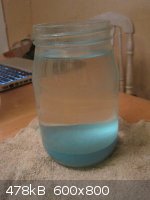
This was set in a saucepan of boiling water and left to digest for an hour. After it settled overnight, the clear liquid supernate was decanted. The
jar was filled with filtered water and the precipitate stirred (so as to dissolve any residual sodium sulfate). This was again left to settle
overnight and then decanted, and this process was repeated once more.
The precipitate was transferred to a shallow glass pan and dried for three hours in an oven at 90C, then broken up and dried for another hour at this
temperature.
The result was 33g of a relatively free-flowing blue powder. Note: this dust becomes airborne easily and is irritating when inhaled, even in small
quantities.
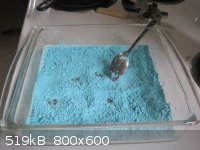 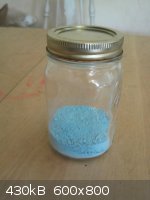
Discussion
One uncertainty I had before performing this experiment was whether copper borate would actually precipitate before copper carbonate, given that both
anions are available in this solution. One reason I heated the solution at near boiling for an hour following precipitation was to test for the
presence of copper carbonate - under such conditions it would decompose to CuO and visibly darken the precipitate if it were present in any quantity.
But no such darkening was seen.
The weight of the collected powder is consistent with a stoichiometry along the lines of
CuB<sub>2</sub>H<sub>2</sub>O<sub>5</sub>
(CuB<sub>2</sub>O<sub>4</sub>.H<sub>2</sub>O). 200mmols of this compound would weigh slightly more than 33g. I
believe that mechanical losses of copper (and by extension copper borate) were very small in this preparation. The decanted liquid was always clear
(no visible quantities of Cu++) and no more than a few hundred milligrams of powder were lost during various transfers.
Further Work
I plan to see whether this compound will further dehydrate (to CuB<sub>2</sub>O<sub>4</sub> on heating above 200C. I'll also be interested to see whether it, like boric acid, becomes more soluble in the
presence of diols. on heating above 200C. I'll also be interested to see whether it, like boric acid, becomes more soluble in the
presence of diols.
The less you bet, the more you lose when you win.
|
|
|
bfesser
Resident Wikipedian
    
Posts: 2114
Registered: 29-1-2008
Member Is Offline
Mood: No Mood
|
|
Strange. That looks nothing like the copper borate I prepared many years ago. What you have appears to be <a
href="http://en.wikipedia.org/wiki/Copper_carbonate" target="_blank">copper(II) carbonate</a> <img src="../scipics/_wiki.png" /> +
<a href="http://en.wikipedia.org/wiki/Copper(II)_hydroxide" target="_blank">copper(II) hydroxide</a> <img src="../scipics/_wiki.png"
/>. Test it for <a href="http://en.wikipedia.org/wiki/Effervescence" target="_blank">effervescence</a> <img
src="../scipics/_wiki.png" /> with dilute acid.
<strong><a href="viewthread.php?tid=16452">Copper Borate?</a></strong>
From an old laboratory notebook of mine, rife with error, terrible assumptions, and just plain awful note-taking: | Quote: | <u>01.12.06</u>
<u>Copper (II) <del>Borate</del> Tetraborate — CuB<sub>4</sub>O<sub>7</sub>:</u>
- 10ml CuSO<sub>4</sub>(aq) solution added to 50 ml beaker containing 10 ml
Na<sub>2</sub>B<sub>4</sub>O<sub>7</sub>(aq) solution
- immediately formation of cloudy blue precip is observed
- phase sep observed with clear solution on top and blue solution below the precip
- added stir bar and put on mag. stirrer for a few minutes with 30 sec. reverse on
- while the reaction was on the stirrer, a few drops were pipetted off into a 10 x75mm test tube and a few drops of CH<sub>3</sub>COOH 1
<u>M</u> were adddd, then the tube was vortexed
- the precip dissolves with Acetic Acid – use it to clean glassware in experiment
-stored in labeled bottle to filter later
<del><u>Anhydrous MgSO<sub>4</sub>(s) + Acetic Acid</u></del>
- after the precip was allowed to settle for a while, the clear solution was blue, indicating an excess of CuSO<sub>4</sub>(aq), so some
more Na<sub>2</sub>B<sub>4</sub>O<sub>7</sub>(<em>aq</em> was added to the bottle was added to the bottle
- I tried filtering the mix in a few ways, but nothing seemed to work very well, so I plan to 'borrow' some time on the lab centrifuges to separate
this
- According to the notes on the "Cobalt Borates" experiment, gravity filtration after settling and decanting was used to successfully recover the
CoB<sub>4</sub>O<sub>7</sub>(s) precipitate — it might be worth a try in this case, since
CuB<sub>4</sub>O<sub>7</sub>(s) is <u>very</u> similar
- be sure to 'rinse' the precip with a few portions of distilled water to remove excess
Na<sub>2</sub>B<sub>4</sub>O<sub>7</sub><em>(aq)</em> and CuSO<sub>4</sub>
(<em>aq</em> that would crystallize onto the precip when drying that would crystallize onto the precip when drying
<u>Reaction Equation: </u>
Na<sub>2</sub>B<sub>4</sub>O<sub>7</sub>(aq) + CuSO<sub>4</sub>(aq) →
CuB<sub>4</sub>O<sub>7</sub>(s) + Na<sub>2</sub>SO<sub>4</sub>(<em>aq</em>
Na<sub>2</sub>B<sub>4</sub>O<sub>7</sub>----------201.220g/mol
CuSO<sub>4</sub>-------------159.610g/mol
Na<sub>2</sub>SO<sub>4</sub>-----------142.044g/mol
CuB<sub>4</sub>O<sub>7</sub>-----------<del>1</del>218.786g/mol
- Gravity filtration works (using Whatman #1 )
- filter paper with wet precip transferred from funnel to 150mL Porcelain Evaporating dish and covered loosely with a paper towel to dry
|
If I were you, I would perform a test tube scale experiment where <a
href="http://en.wikipedia.org/wiki/Borax" target="_blank">sodium tetraborate</a> <img src="../scipics/_wiki.png" /> is prepared first,
then reacted with the <a href="http://en.wikipedia.org/wiki/Copper(II)_sulfate" target="_blank">copper(II) sulfate</a> <img
src="../scipics/_wiki.png" /> solution. In my experience, copper(II) sulfate will react with <a
href="http://en.wikipedia.org/wiki/Sodium_bicarbonate" target="_blank">sodium bicarbonate</a> <img src="../scipics/_wiki.png" />,
precipitating copper(II) bicarbonate (rxn. I), which quickly decomposes (rxn. II) to copper(II) carbonate. It seems that the crude copper(II)
carbonate can vary widely in color from a light blue (as you have) to an ugly green (I couldn't find my samples). It's likely that the composition of
the crude product includes various hydrates, <a href="http://en.wikipedia.org/wiki/Copper(II)_oxide" target="_blank">copper(II) oxide</a>
<img src="../scipics/_wiki.png" />, and perhaps even a little stabilized copper(II) bicarbonate.<strong><ol
type="I"><li>CuSO<sub>4</sub>(aq) + 2 NaHCO<sub>3</sub>(aq) → Cu(HCO<sub>3</sub> <sub>2</sub>(s) +
Na<sub>2</sub>SO<sub>4</sub>(aq)</li> <sub>2</sub>(s) +
Na<sub>2</sub>SO<sub>4</sub>(aq)</li>
<li>Cu(HCO<sub>3</sub> <sub>2</sub>(s) →
CuCO<sub>3</sub>(s) + CO<sub>2</sub>(g) + H<sub>2</sub>O</li></ol></strong>But after reviewing
your procedure, I would expect any copper(II) carbonate/bicarbonate to react with the boric acid (depending on pH). I wouldn't be surprised if you
had too much bicarbonate and accidentally precipitated the carbonate. But I could just be talking out of my arse… <sub>2</sub>(s) →
CuCO<sub>3</sub>(s) + CO<sub>2</sub>(g) + H<sub>2</sub>O</li></ol></strong>But after reviewing
your procedure, I would expect any copper(II) carbonate/bicarbonate to react with the boric acid (depending on pH). I wouldn't be surprised if you
had too much bicarbonate and accidentally precipitated the carbonate. But I could just be talking out of my arse… Quote: Originally posted by blogfast25  | Boric acid is an acid in name only, it is likely to be too weak to attack a water insoluble carbonate like CuCO3.
. . .
Likewise with the reaction between a neutral cupric salt and a borax solution: the high alkalinity of the borax solution is likely to precipitate
either Cu(OH)2, a basic cupric salt or basic cupric borate. But it’s hard to tell which, without a solubility product (K<sub>sp</sub> for the target cupric borate. for the target cupric borate. |
[note] I
searched, but couldn't seem to find my old copper precipitates. From what I remember, after drying the filter cake it formed a <u>dark blue
rock hard mass</u>. I recall even having difficulty grinding it in the mortar to fit into a vial. Alas, the difference could just be the way I
prepared and filtered my precipitate, I could have had Cu(OH)<sub>2</sub> (possibly what you have, as well), or my memory could be faulty.
[Edited on 28.7.13 by bfesser]
|
|
|
bbartlog
International Hazard
    
Posts: 1139
Registered: 27-8-2009
Location: Unmoored in time
Member Is Offline
Mood: No Mood
|
|
It certainly *looks* like copper carbonate! But heating near boiling should have destroyed that compound. Nonetheless, your suggestion of an acid test
is a good one.
It would not surprise me if some other copper borate looked rather different; I was trying to precipitate something containing two atoms of boron for
every one of copper, but based on the information in the thread you link to above, there are compounds with other ratios, including three copper per
two boron atoms. Which, if we regard boric acid as triprotic, might be better regarded as the 'true' copper borate, with my compound being copper
metaborate hydrate...
The less you bet, the more you lose when you win.
|
|
|
Vargouille
Hazard to Others
  
Posts: 380
Registered: 16-4-2012
Member Is Offline
Mood: No Mood
|
|
I've tried to make the copper tetrahydroxyborate (Cu[B(OH)4]2) complex between boric acid and copper carbonate twice so far, and haven't succeeded
yet. I mixed stoichiometric amounts of the two with enough water to dissolve the boric acid, and heated (boiled during the second trial) in the hopes
of simultaneously prodding the boric acid into reacting and removing the resulting carbon dioxide. The first time, I stopped after a short time, and
was left with a blue precipitate which bubbled upon addition of sulfuric acid. The second time, I got the same result, but I saved the remaining
solution, and upon allowing it to evaporate, I received some amount of a white/clear crystalline substance which I took to be unreacted boric acid.
Apparently copper tetraborate is quite simple to make, mind you.
|
|
|
bbartlog
International Hazard
    
Posts: 1139
Registered: 27-8-2009
Location: Unmoored in time
Member Is Offline
Mood: No Mood
|
|
Aside from the fact that no decomposition has been observed - which could just be because I haven't heated it enough - there's the issue that the
powder weighs too much to be CuCO<sub>3</sub>. 200mmol of copper carbonate would only weigh 25g, and this powder weighs 33g. Anyway, I'll
see tomorrow whether it effervesces on addition of HCl.
Your lab notes are neat, but unfortunately the first entry doesn't tell us the concentrations of the solutions being mixed - which leaves us in the
dark as to what sort of stoichiometry we're looking at.
[Edited on 21-7-2013 by bbartlog]
The less you bet, the more you lose when you win.
|
|
|
bfesser
Resident Wikipedian
    
Posts: 2114
Registered: 29-1-2008
Member Is Offline
Mood: No Mood
|
|
Those notes were crap. I just had nothing better to do than type them out. As for the weights, how dry is your product? Also, if it contained (a
somehow stabilized) Cu(HCO<sub>3</sub> <sub>2</sub>, this
would help to account for the discrepancy in mass. <sub>2</sub>, this
would help to account for the discrepancy in mass.
|
|
|
bbartlog
International Hazard
    
Posts: 1139
Registered: 27-8-2009
Location: Unmoored in time
Member Is Offline
Mood: No Mood
|
|
Tested as follows:
- took a spatula of the putative copper borate, put it in a test tube, and added 15ml of household vinegar. No effervescence was seen, but
interestingly the solution did become colored blue, and on addition of another 15ml of vinegar all of the copper compound eventually dissolved.
Wasn't sure how dispositive this was, since acetic acid is pretty weak and will for example take quite some time to displace
CO<sub>2</sub> from calcium carbonate. So -
- took a somewhat larger quantity of the copper compound, a bit more than a gram, and put it in the bottom of a test tube. Added 10ml of 31% HCl.
Immediately the liquid turned deep green, and a bit of foam was seen at the top. Note though that if we had 10mmol of CuCO<sub>3</sub>
(about what we would have given the rough estimate of weight), the gas volume produced would have to be over 200ml (and actually I would expect the
solution to be ejected from the test tube). I'm guessing the foam is due to some small carbonate impurity, but it looks like it would have to be less
than 1%.
After diluting the HCl with a similar quantity of water, I took a picture, which shows a precipitate at the bottom. This I would presume to be boric
acid, freed from the copper. When I dumped the solution I could see that the precipitate was white, which consistent with that idea.
tl;dr Yes, it looks like it's copper borate.
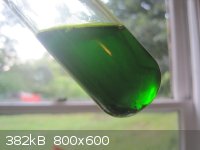
The less you bet, the more you lose when you win.
|
|
|
H2libfront
Harmless

Posts: 2
Registered: 23-2-2013
Member Is Offline
Mood: No Mood
|
|
I once made some 'copper tin green' which was used as a pigment in the old days. (I made it because I wanted to test it as exotic thermite, but that
didn't really work unless I first decomposed it)
I think the formula is CuSnO3, copper stannate, and I made it by dropwise adding copper sulfate solution to a sodium stannate solution (made from
SnCl2 solution with excess NaOH). The precipitate was brown when hydrated, but dried to a beautiful green.
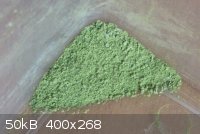
[Edited on 22-7-2013 by H2libfront]
Liberate hydrogen from it's oppressive bonds!
|
|
|
Bezaleel
Hazard to Others
  
Posts: 444
Registered: 28-2-2009
Member Is Offline
Mood: transitional
|
|
Copper antimonite
Interesting. You can also make a copperantimonite, Cu(SbO2)2, by reacting freshly precipitated copperhydroxide with antimonytrioxide. You can tell the
reaction by the colour change towards a very light green, lighter and more whitish than the green shown in H2libfront's picture above, but otherwise
very similar in hue. If I remember well (but I would need to look that up), the reaction requires an alkaline environment to take place.
|
|
|
| Pages:
1
2
3
4 |